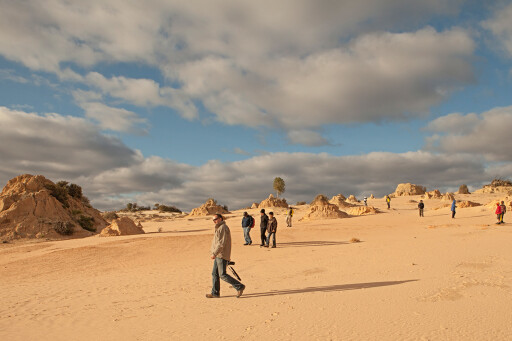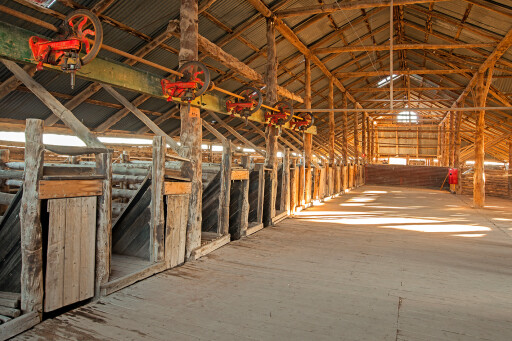
Located in the far south-west of New South Wales, Lake Mungo dried up some 18,000 years ago and what now looks like a largely barren plain hides the story of a very different ancient history.
This was first published in 4x4 Australia's January 2014 issue.
We left Melbourne in light rain and true to prediction the sky cleared as we crossed the Murray River near Swan Hill and continued our journey north towards Balranald. Rather than take the conventional route to Lake Mungo via Mildura, we opted for the shorter direct run which saw us leave the bitumen 55km north of Balranald and head west on secondary roads.
This area saw significant rain early in 2012 on top of downpours of biblical proportions in 2011. The significant damage suffered by the minor roads was immediately apparent.
 Some sections that had been repaired were good for 100kph, while others were like driving on cobblestones because the surface clay and gravel had been washed away exposing the larger rocks below.
Some sections that had been repaired were good for 100kph, while others were like driving on cobblestones because the surface clay and gravel had been washed away exposing the larger rocks below.
None of this would present an issue for a four wheel drive with good all terrain tread, but lesser vehicles with low profile rubber or those towing vans would be advised to check out the conditions with the park Ranger before venturing into this area. Lake Mungo has only one camping area other than a bush camp some 20 kilometres away on the other side of the lake from the main entrance.
The main camp was surprisingly busy considering it was winter and very cold at night, but being more or less half-way between Sydney and Adelaide, Lake Mungo is a convenient stopover spot. We arrived just before dusk and got the last site with a fireplace that we could back our camper into.
By 10am the next morning 80 per cent of the campers had packed up and moved on - so the moral of the story is plan to arrive early. The camp has a couple of drop toilets but no shower – although you can drive 3 kms to the visitors centre and use the public showers located there. The visitors centre also offers bunkhouse accommodation in their refurbished shearers quarters.
 Half our group decided to opt for the (warmer) luxury of cabin accommodation at Mungo Lodge 2 kms west of the camping ground. The Lodge has a bar and restaurant and a dozen or so self contained cabins - much more civilised than crunching through the frost in the dark on your way to the drop toilets!
Half our group decided to opt for the (warmer) luxury of cabin accommodation at Mungo Lodge 2 kms west of the camping ground. The Lodge has a bar and restaurant and a dozen or so self contained cabins - much more civilised than crunching through the frost in the dark on your way to the drop toilets!
The main attraction of Lake Mungo is the sand sculptures formed by the erosion of an ancient dune on what was the lake’s eastern shore before it dried up some 18,000 years ago as a result of climate change. These formations present in different colours (yellow, orange, red, grey) depending on when the sand was originally laid down.
In the early morning or evening light they take on an eerie appearance and make great photographic subjects. Ancient history is also being revealed by the erosion of the dune - much of which was started by rabbit plagues in the late 1800’s. As the wind slowly peels away the layers of sand, the bones of prehistoric wombats the size of cattle are being revealed.
 The skeletons of Mungo Woman and Mungo Man who were discovered here in 1969 and 1974 respectively represent the oldest known human remains found in Australia. Mungo Woman is also the oldest evidence of human cremation in the world. Human habitation of Lake Mungo has been shown to exist as far back as 40,000 years ago.
The skeletons of Mungo Woman and Mungo Man who were discovered here in 1969 and 1974 respectively represent the oldest known human remains found in Australia. Mungo Woman is also the oldest evidence of human cremation in the world. Human habitation of Lake Mungo has been shown to exist as far back as 40,000 years ago.
A must do for any visitor to Lake Mungo is the discovery tour run by the aboriginal owners and managers of the National Park. Those participating in the tour are taken into areas closed to the public (which is practically all of the dune) and shown relics of previous habitation – 30,000 year old fire sites, stone knives, middens, along with the unique erosion Lake Mungo is famous for.
The rangers also explain what the various trees and shrubs were used for - most had medicinal or dietary value to the original inhabitants. Bush tucker is everywhere when you know where to look - such as the bush tomato with its small red tomato-like fruit.
 I’d never really noticed this small unassuming plant but now realise it is very common and must have been great source of nourishment for the original inhabitants. The tour ends on the top of live dunes which are slowly moving with the prevailing winds into the plains to the east of the lake.
I’d never really noticed this small unassuming plant but now realise it is very common and must have been great source of nourishment for the original inhabitants. The tour ends on the top of live dunes which are slowly moving with the prevailing winds into the plains to the east of the lake.
The old Mungo Woolshed near the visitors centre was built by Chinese labour around 1869 from local Cyprus pine which is resistant to termites. When you consider all the wood in this large building was cut locally and hand sawn into planks you get an idea of the effort involved. The Chinese came from Victoria seeking work after the gold diggings down south began to show poorer returns.
Apparently the dune on the eastern bank of the lake was named the Wall of China by these workers as some of its features supposedly reminded them of their homeland. Beyond the Wall of China a 70 km one way gravel road takes visitors into the grassland and mallee country to the east of Lake Mungo before looping around to the north and returning to the visitors centre.
 Half-way along this track a 500 metre long “Mallee Walk” has been established with the different types of trees and shrubs labelled with their names. The low mallee trees were covered in blossom and alive with parrots and honeyeaters. Smaller birds such as pardalotes and wrens could be seen chasing the insects attracted by the flowers.
Half-way along this track a 500 metre long “Mallee Walk” has been established with the different types of trees and shrubs labelled with their names. The low mallee trees were covered in blossom and alive with parrots and honeyeaters. Smaller birds such as pardalotes and wrens could be seen chasing the insects attracted by the flowers.
It’s well worth stretching your legs for 30 minutes or so to get a little closer to nature. A little further on is Beulah Camp, a large shady camp site set in a grove of Sheoaks. The camp has a drop toilet, but open fires of any type are prohibited.
At the northern most section of this ring road is a short side track to Vigars Well which was originally a watering site for the Cobb & Co coach run from Broken Hill to White Cliffs. Apparently the compressed impression of wagon tracks can be still be seen in the area (unfortunately the information didn’t say where to look!).
 From the well you can walk onto the live dunes at the back of the Wall of China (the only place public access to the dunes is permitted). The moving sand shows a record of what has walked across it since the last breeze wiped it clean.
From the well you can walk onto the live dunes at the back of the Wall of China (the only place public access to the dunes is permitted). The moving sand shows a record of what has walked across it since the last breeze wiped it clean.
While the dunes seem devoid of any life the sand shows that not to be true with tracks of emus, kangaroos, foxes, wild cats and goannas everywhere. Again the occasional tell tale sign of ancient human habitation was evident – the dark stain of an old fire place, animal bones and stone shards in the sand.
Once back on the lake bed the road passes the ruins of Zanci Homestead. Little remains of the homestead except the stables and an underground coolstore. However, the nearby Zanci Woolshed, built in 1922 and originally part of the larger Mungo Woolshed some 6 kms away has been well maintained and is now used as an interpretive centre.
A days drive from Adelaide, Melbourne or Sydney, Lake Mungo is steeped in history and whether you’re a bushwalker, photographer or just looking for a few days away with the tent or camper it’s an interesting place to stop off.
CONTACTS
Lake Mungo Visitor Centre: (03) 5021 8900
Web: visitmungo.com.au/visitor-centre
Mungo Lodge: (03) 5029 7297
Web: mungolodge.com.au

COMMENTS